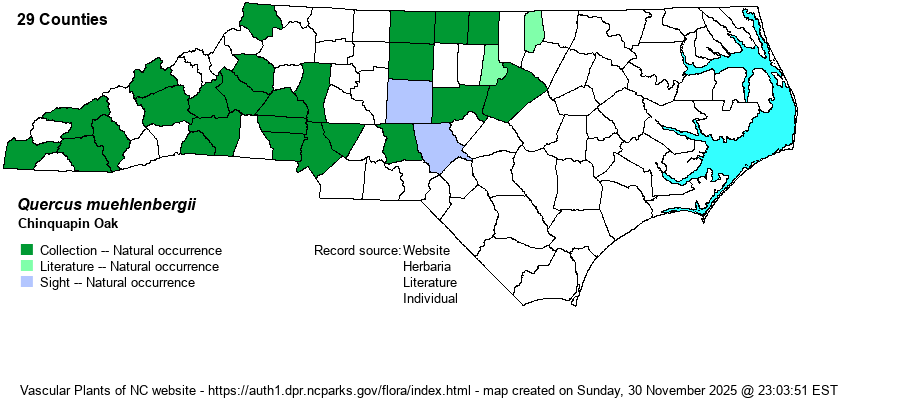| Section 6 » Order Fagales » Family Fagaceae |
Show/Hide Synonym
| taxonName | relationship | relatedTaxonName | relatedTaxonRefText | relComments |
|---|
|
|
|
|
|
|
|
|
|
| Quercus muehlenbergii | = | Quercus muhlenbergii | Flora of North America (1993b, 1997, 2000, 2002a, 2002b, 2003a, 2004b, 2005, 2006a, 2006b, 2006c, 2007a, 2009, 2010) | , orthographic variant | | Quercus muehlenbergii | = | Quercus muhlenbergii | | , orthographic variant | | Quercus muehlenbergii | = | Quercus muhlenbergii | | , orthographic variant | | Quercus muehlenbergii | = | Quercus muhlenbergii | Small (1933, 1938) | , orthographic variant | | Quercus muehlenbergii | = | Quercus muhlenbergii | | , orthographic variant | | Quercus muehlenbergii | = | Quercus muhlenbergii | Wofford (1989) | , orthographic variant | | Quercus muehlenbergii | = | Quercus prinoides var. acuminata | Gleason (1952) | | | Source: Weakley's Flora |
|
| Author | Engelmann | |
| Distribution | Scattered over all of the Mountains and most of the Piedmont, but with records for perhaps just 50-60% of the counties. Ranges east to Vance and Wake counties. A report for Beaufort County, in the eastern Coastal Plain, is suspected to be in error, as the species seems unknown elsewhere in the state in that province.
This is an Eastern species but with its abundance centered in the Midwest, in the Ohio and Mississippi valleys. It ranges north to VT and barely to MN, and south to the FL Panhandle and NM.
| |
| Abundance | Generally rare to locally uncommon in its NC range, being quite rare in the eastern Piedmont. It is nowhere common, and to find it one normally has to visit known sites, as it usually is not to be seen in random walks in these regions. This is an NC Watch List species. | |
| Habitat | The species strictly occurs on high pH soil, in a variety of settings and over a variety of rocks. It typically occurs on mesic slopes, the farther east in the state normally the richer the site (e.g., mainly in Basic Mesic Forests). In the Mountains and foothills, it can occur over limestone or other rocks in drier settings, but still always over high pH soil. |
| Phenology | Flowers in April and May, and fruits in October and November of the same year. | |
| Identification | This is a medium to rather large deciduous tree, growing to about 80-90 feet tall. Though familiar to biologists living west of the Appalachians, it is not well known in East Coast states. It has fairly “standard” tight, scaly/plate-like gray bark, a bit like that of Swamp Chestnut Oak (Q. michauxii), which can grow with it near the base of rich slopes. Chestnut Oak (Q. montana) has deeply furrowed gray bark, with vertical ridges and “valleys”, quite different from the other two. Chinquapin Oak leaves are mostly elliptical to a bit obovate or oblanceolate, averaging narrower than those of the other two, but you need to look at leaves on the upper part of the tree, as lower leaves (and leaves of saplings) can look broader and more obovate. Also, Chinquapin Oak leaves have more triangular lobes, and not rounded ones like the other two species. It also has quite small acorns, though for much of the season acorns will not be available for observation. Thus, you could overlook this species in NC, as it is scarce; and also you can end up “jumping the gun” and identifying this species when you really have one of the two common ones. Make sure to look at leaves in the upper half of the tree. Note: the poorly known Dwarf Chinquapin Oak (Q. prinoides) is very rare in NC and is a clonal shrub. Needless to say, do not attempt to identify oaks (of most species) when they are only 1-3 feet tall, unless acorns are already on them! | |
| Taxonomic Comments | The species was often named, and originally was, as Quercus muhlenbergii. It has been corrected to muehlenbergii.
| |
| Other Common Name(s) | Chinkapin Oak | |
| State Rank | S2 [S3] | |
| Global Rank | G5 | |
| State Status | W1 | |
| US Status | | |
| USACE-agcp | UPL link |
| USACE-emp | UPL link |

